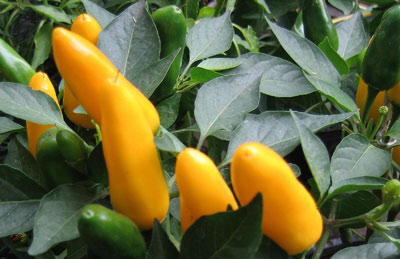| GreenGardeningCookingCuring.com | CHILES
AND HOT PEPPERS PAGE |
| HOME |
| Tour Our Destination Websites | Taxco-Today.com | Oaxaca-Today.com | Montserrat-Today Site |
| See our silver designs at Krika.com | Read our travel stories and other tales at Krika.com |
|
|
Hot Peppers What I find more interesting than the simple heat of chiles is their very distinctive flavors. Each of them imparts a unique taste which enhances the flavors of other foods. All chiles are great sources of vitamins A and C and good sources of folic acid, potassium and vitamin E. As you can imagine for two people who have lived for years in Mexico, chiles are one of our dear favorite foods. They add color and a kick to many wonderful dishes. Not all of them are hot and many have interesting layers of flavor. The manzano chile is a good example. With its peppery heat comes a nuance of melon. Benefits: Capsaicin which gives peppers their heat, is said to be similar to a common ingredient in decongestants. Adding a sprinkle of cayenne or another hot pepper to a hot cup of tea may help in beginning to drain clogged nasal passages helping you to breathe more easily and maybe even work on getting rid of that nasty sinus headache. This has worked reasonably well for my husband so give it a try if you suffer as he does. Peppers may also be good for your heart and for your circulation as they may lower unwanted LDL cholesterol while augmenting beneficial HDL cholesterol. Recently I read that hot peppers may reduce the risk of ulcers, killing the very bacteria that is now known to cause this dreadful stomach disorder. Apparently, the hot peppers kill the ulcer causing bacteria! I have always had a weak stomach, it being the place I'd always first feel stressful situations. When I moved to Mexico, not only did I leave the stressful situations behind for the most part, I also began eating hot peppers on a daily basis and I never had a stomach problem while doing so even under relatively stressful situations. Link: http://www.g6csy.net/chile/var-b.html Warnings: Another cautionary note can be added regarding unfamiliar hot peppers you may encounter while traveling. By all means give them a try, but do so in the manner in which you have seen them prepared. Are they eaten raw, raw with the skins burned off, cooked and skinned? I don't think you will find yourself in dire straits if you break a few rules, but we have had some pretty serious digestive upsets eating some of the Mexican hot peppers not prepared traditionally. In any case I would recommend asking how new peppers are prepared before just jumping in with your own ideas of what to do with them. Text & Photograph ©KO 2006 and ©GreenGardeningCookingCuring.com 2013 |
|||
| Cayenne
Peppers Benefits: This is one of the hot peppers and not everyone will find it appealing. If you do, you may reap the benefits of clearer breathing, lower cholesterol and an increase in your metablolism. |
|||
|
|||
Chile
Ancho Capsicum
annuum |
|||
| Chile
Arbol
Japones These are skinny red dried chiles used in making salsa roja or red salsa. They are hot, as is the salsa. Text Copyrighted ©KO 2006 |
|||
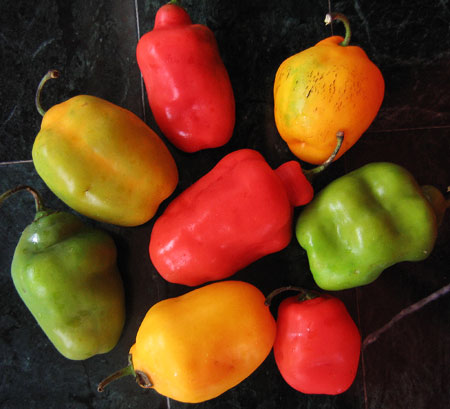 Chiles
Caballos Chiles
CaballosThese little chiles (about 3" top to bottom) look much like those that I loved in Mexico, the twice larger chiles manzanos, but they are different, lacking the fruity taste that made manzanos so exquisite. Benefits: From: Guatemala is where we found them. Photographed: In our kitchen in Panajachel at Lake Atitilan in Guatemala. Planting and Care: Text and Photograph Copyrighted ©GreenGardeningCookingCuring.com 2013 |
|||
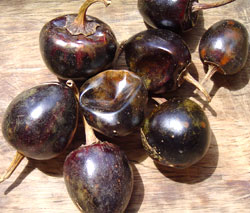 Chile
Cascabel Capsicum
annuum Chile
Cascabel Capsicum
annuumThis dried chile is used in making a terrific salsa. Its name, cascabel, means little rattle in Spanish. They are small, almost round and from about 1 to 2" in length. The color is almost the same as an eggplant, a dark brownish black. Photographed: We bought these chiles in the market and took them home to photograph them at our apartment in Taxco, Mexico. To see some of the foods available in Taxco's market and some of our favorite people click here. Text & Photograph Copyrighted ©KO 2006 |
|||
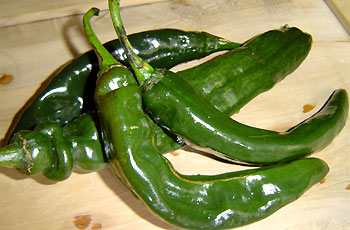 **Chile
Chilaca Capsicum **Chile
Chilaca CapsicumThis is a long relatively thin deep green fresh chile with moderate heat. When dried it is called a chile pasilla. The chilaca is intriguing because it has overtones of a regular green bell pepper with a unique warm spicy heat. In Mexico, it is used most frequently in salads sliced fresh with tomatoes, onions and a bit of garlic. We love it sliced and fried with onions and served with fried steak. Photographed: We bought these chiles in the market and took them home to photograph them at our apartment in Taxco, Mexico. To see some of the foods available in Taxco's market and some of our favorite people click here. Text & Photo Copyrighted ©KO 2006 |
|||
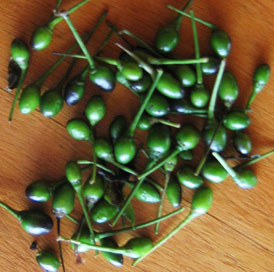 **Chile
Chiltepe **Chile
Chiltepe These are tiny chiles that grow well here at a mile high and in a climate that is relatively moist because of Lake Atitlan. They are known locally to be very hot. When local folks come to visit they always take a meandering walk through the garden to see if any of these chiles are ready to pick. Benefits: From: Guatemala is where we found them in our garden. Photographed: In our garden at our home in Panajachel, Solala, Guatemala. Planting and Care: Text and Photograph Copyrighted ©GreenGardeningCookingCuring.com 2013 |
|||
|
|||
|
Put
1/4 kilo (about ½ pound) of chipotles in a pot and cover
them with water. Simmer gently until the chiles soften, but not
long enough for them to break apart. In a separate pan, soften
a cone of piloncillo in a small amount of water, add ½ cup
of vinegar and ½ of a small stick of cinnamon. If you
don’t have access to piloncillo, use about 1/2 cup of molasses.
Cook these together till it smells wonderful. Drain the chipotles
and add to the other mixture. Stir gently over low heat to blend
the flavors. Serve with meats as a side dish. |
|||
| Chile
Guajillo Ancho Capsicum Wider in shape and less piquant than its cousin guajillo pulla. Text Copyrighted ©KO 2006 |
|||
RECIPE -- TOMATO JUICE COCKTAIL Chop
some guajillo pullas finely and add a tablespoon or so to a tall
glass. Squeeze 1/2 key lime into the glass, add tomato juice
and vodka to taste leaving room for the ice. Stir the mixture,
add a stick of celery with nice green leaves and finally some
ice. Delicious! |
|||
| **Chile
Habanero, Chile Macho Capsicum chinense These are small 2" green, yellow or red fresh chiles. A bit misshapen, the habanero is also extremely hot. Photographed: We bought chiles in the market and took them home to photograph them at our apartment in Taxco, Mexico (on the right). To see some of the foods available in Taxco's market and some of our favorite people click here. On the left is a fresh green habanero growing in our mahogany garden at our former home in Montserrat. Planting and Care: The habanero plant is not distinctive from other chile plants, growing at its best to over three feet tall, but bearing even when smaller in about 85 days. Surprisingly we found worms in some of our first habaneros and couldn’t imagine how anything could live in one of these chiles! After the initial worm problem, we had good luck with this chile in Montserrat giving it the same care as all of our other chiles and sweet peppers -- sun and routine rainfall or watering. Before planting, we prepared the soil well adding compost and lime and then waiting a week before transplanting the habanero seedlings I had grown with seeds brought from Mexico. Text & Photographs Copyrighted ©KO 2006/2010 and GreenGardeningCookingCuring.com 2013 |
|||
|
|||
|
|||
RECIPE #1: CHILE MANZANO SALAD Slice the chiles manzanos, removing the pith and seeds, and mix them with about 1/3 as many very thinly sliced mild white or Bermuda onions by volume. Add a bit of salt and squeeze fresh key lime juice over them to taste. |
|||
RECIPE #2: CHILES CAPONES Core the manzanos leaving the pepper in tact. Cook them in water with key lime juice, salt, onion, and a bit of bicarbonate of soda (to reduce the heat if you wish). When softened and cool enough to touch, stuff the chiles with cooked freshly ground beef made from an organically raised cut of sirloin. Salt as desired and then give them a topping of dry white cheddar cheese. Bake at 375° F. for about 1/2 hour or until the cheese is bubbly. Serve with a puree of black beans, small (not grape) round cherry tomatoes, and fresh tortillas or the best tortilla chips you can find if you can't make them yourself. |
|||
|
|||
|
|||
RECIPE: HUEVOS DIVORCIADOS Dried
or fresh these chiles are used in making a salsa picante or
hot sauce. The salsa is used in making huevos divorciados or
divorced eggs. In this dish, two fried eggs are served, one with
salsa picante and one with a mild tomato salsa. You'll find
this on breakfast menus all over Mexico. |
|||
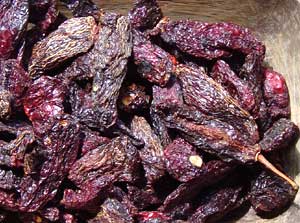 Chile
Morita Capsicum Chile
Morita CapsicumShaped like a dried jalapeno, or chipotle, the morita is about 3 to 4" long. It is almost always used dried, most often in making salsa. Photographed: We bought these chiles in the market and took them home to photograph them at our apartment in Taxco, Mexico. To see some of the foods available in Taxco's market and some of our favorite people click here. Text & Photograph Copyrighted ©KO 2006/2010 |
|||
Chile
Mulato Capsicum |
|||
|
|||
|
|||
|
|||
|
|||
| **Chile
Serano Capsicum
annuum The serano is a relatively small chile, narrow and only 2 to 4" in length. It is a standard item in any Mexican kitchen, used to add a spike to many dishes while not affecting the flavor much. While it is often rated as hotter than the jalapeno, I would have to say the heat is the same – hot, but not fiery. Photographed: Below in the middle and on the right in our kitchen and in the mahogany garden at our former home in Montserrat. On the lower left we bought the chiles in the market and took them home to photograph them at our apartment in Taxco, Mexico To see some of the foods available in Taxco's market and some of our favorite people click here. Planting and Care: The serano grows on a plant that is about three feet tall. Plant seeds in trays and transplant to the garden for best results. Give them full sun and a reasonable amount of water and fertilizer and you won't be disappointed. They don't seem affected much by insects, though we have had problems with some sort of wilt. Mature chiles can be harvested in about 80 days. Text & Photographs Copyrighted ©KO 2006/2010 and GreenGardeningCookingCuring.com 2013 |
|||
|
|||
| Guyana
Wiri Wiri Pepper, Guyana Pepper, Hot Cherry Pepper, Bird Cherry
Pepper Capsicum Frutescens As you can see in the photograph below these peppers resemble cherry tomatoes and they do carry a little of the tomato taste along with a fruitiness in a tiny pepper that packs a wallop. They are as hot as habaneros and scotch bonnets. They are said to be a staple of Guyanese cuisine. Benefits: Wiri wiri peppers probably carry many of the benefits of hot pepper, but I have not yet found any specific reference to wiri wiri peppers. From: Guyana Photographed: At the Latour Farm in Tobago in January, 2018. Planting and Care: The wiri wiri grows at most to be under 5 feet. It will do well in full sun or in semi shade as long as it receives good rainfall or watering. This is a sub-tropical plant that is tolerant of infrequent occurences of cold weather down to about 30 F. Text and Photograph ©GreenGardeningCookingCuring.com 2018 |
|||
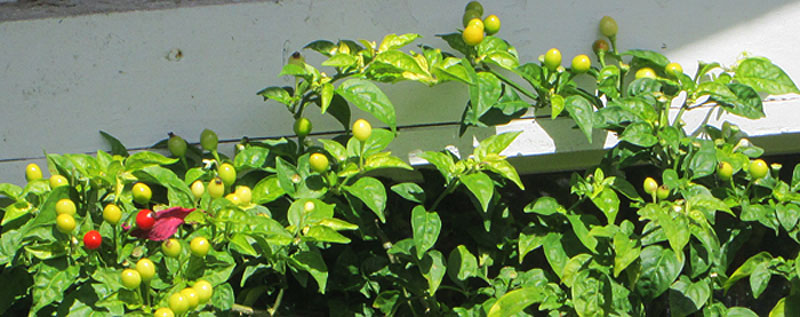 |
|||
| Scotch
Bonnet Peppers, Bonney peppers, Caribbean Red Peppers Capsicum
chinense 'Scotch Bonnet' Scotch bonnets are among the hottest known peppers. They are used extensively in Caribbean and southern Latin American cuisine as well as being popular in Guyana. They are said to have a slightly sweet taste along with the heat. Benefits: Capsicum peppers are known to have all sorts of health benefits, but I couldn't find anything specific to the Scotch bonnet variety. From: I saw one reference saying this plant variety originated in Jamaica, but I can't be certain of that. Photographed: At the Johnston Apartments in Crown Point, Tobago, in 2018. Planting and Care: These pepper plants produce prolific quantities of peppers growing in full sun with routine rainfall or watering. Text and Photographs ©GreenGardeningCookingCuring.com 2018 |
|||
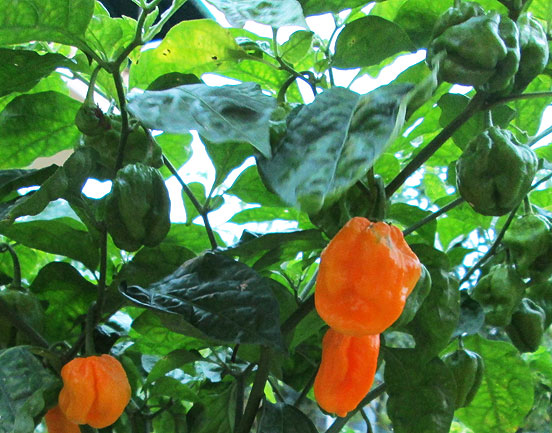 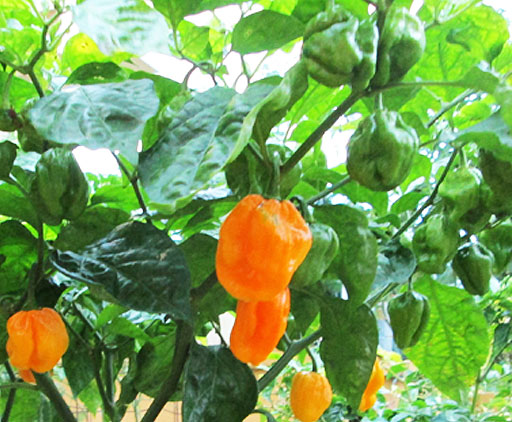 |
|||
SWEET
PEPPERS |
|||
| Black
Pepper Piper nigrum Black pepper is obtained from dried unripe fruits. White pepper results when ripe fruits are fermented to remove their skins and then dried. What surprised me when I received a pepper plant as a gift, is it turned out to be a tree not a bush as I had imagined. The tree is beautiful and yields after about five years. This is one of our trees that lives in Taxco. I haven’t been able to get one in Montserrat. Text ©KO 2004 |
|||
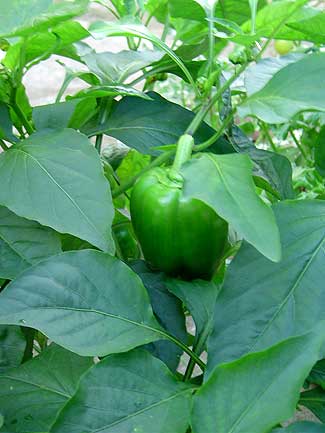 **Green
Peppers, Bell Peppers Capsicum spp. **Green
Peppers, Bell Peppers Capsicum spp.One of the delightful things about growing sweet peppers in a tropical climate is that the plants truly are perennial. Once planted, they will grow and produce lots of peppers for as long as the plants are well cared for. Then they will take a turn for the worse, leaves looking sad and diseased as if the plant were on its last legs. But, within a few weeks you will begin to see new leaves and then new peppers and so on and so on. What a delight! Benefits: When these green peppers turn red they are loaded with Vitamin C, more even than an orange. Photographed: In our mahogany garden at our former home in Montserrat. Planting and Care: Peppers in the tropics will do just fine with a little shade, but they do need very regular watering. You can also leave the peppers on the plants a little longer than you might in a northern climate. Unless it is very hot and dry the peppers will continue growing until they almost resemble those "store bought" peppers -- big, deep green and crunchy. Fertilize them the same as you do your tomatoes. Tropical Climate Varieties: Yolo Wonder, Keystone Resistant Giant Text and Photograph ©KO 2009/2010 and ©GreenGardeningCookingCuring.com 2014 |
|||
**Pepperoncini |
|||
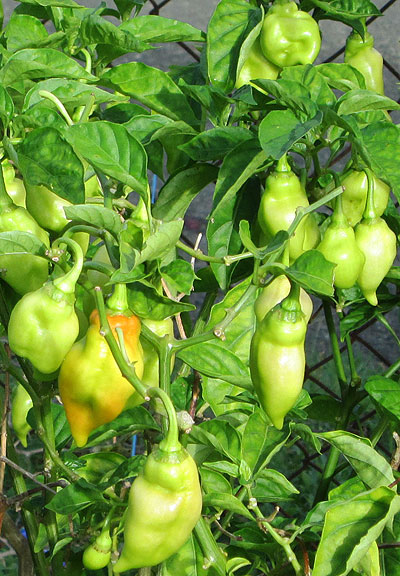 Trinidad
Pimento Peppers, Trinidad Seasoning Peppers Capsicum
chinense Trinidad
Pimento Peppers, Trinidad Seasoning Peppers Capsicum
chinenseThis is perhaps the most popular pepper in Trinidad and Tobago. It is said to pack all the flavor of a hot pepper without the heat. They are sometimes used interchangeably with green bell peppers. Benefits: Capsicum peppers are known to have all sorts of health benefits, but I couldn't find anything specific to the Trinidad Pimento variety. From: I did not find this information. Photographed: At the Johnston Apartments in Crown Point, Tobago, in 2018. Planting and Care: When mature these plants will be about 4 feet high and will be covered in peppers as you see in the photograph. We have seen them growing in gardens, in pots by the door, and just about anywhere else you look. Treat them like green peppers with a fertile rich soil and regular rainfall or watering and they will do just fine. They also seem immune to the Caribbean's very hot direct sun so I wouldn't bother with giving them any shade. Text and Photograph ©GreenGardeningCookingCuring.com 2018 |
|||
MYSTERY
PEPPERS |
|||
If
you know what this chile is, please Contact
Me |
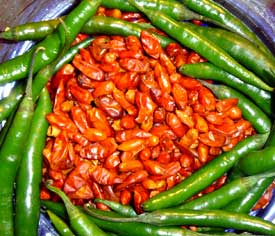
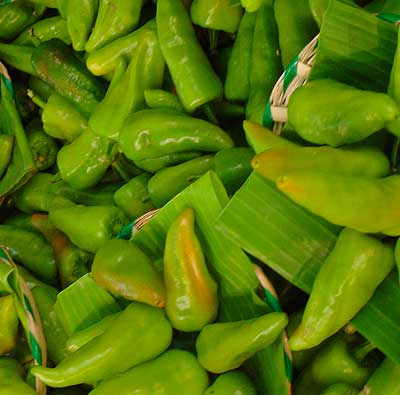
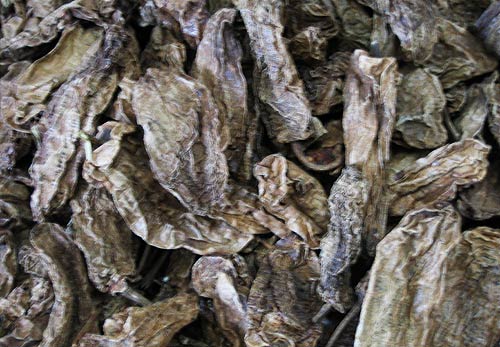
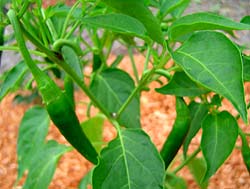
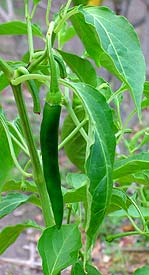
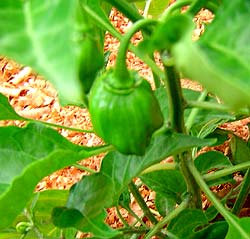
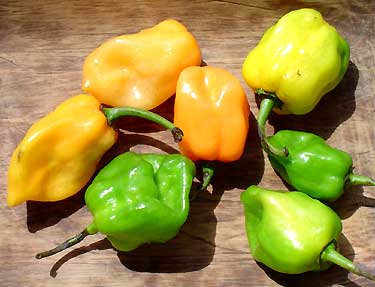
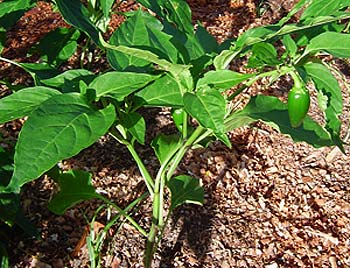
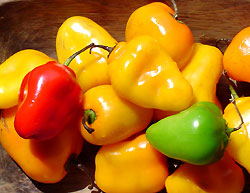
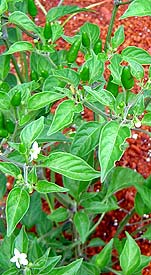
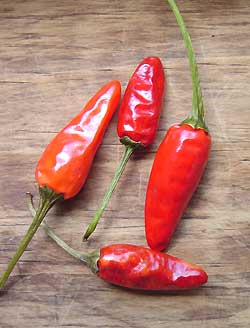
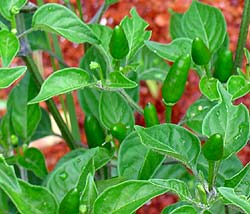
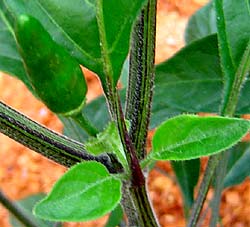
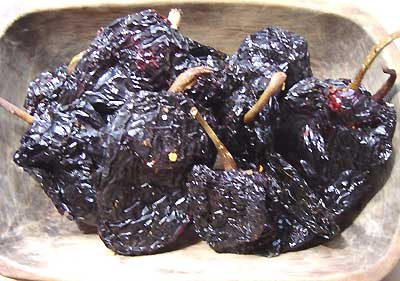
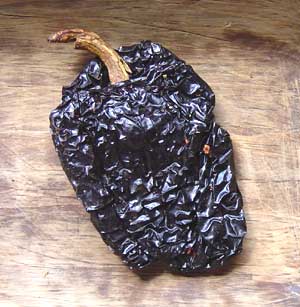
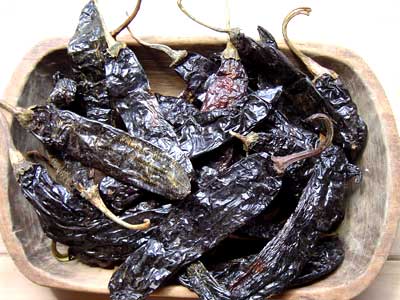
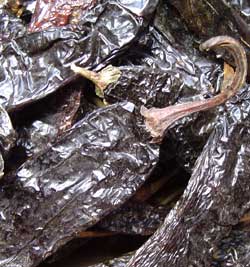
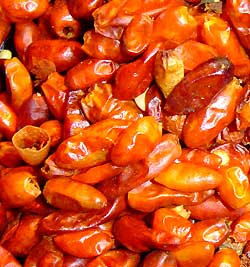
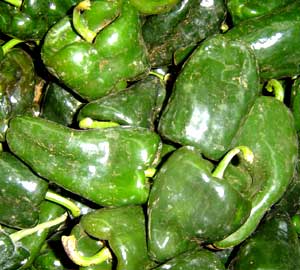
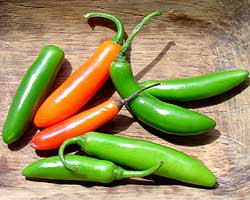
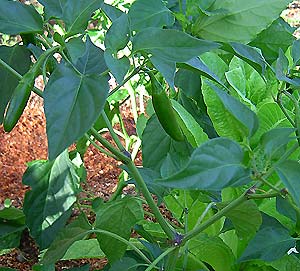
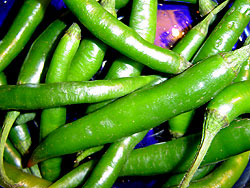
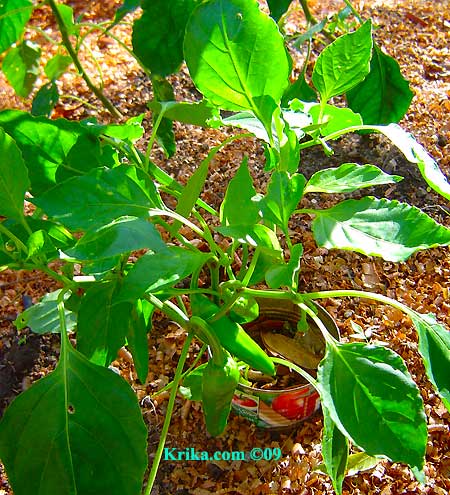 **Italianelle
Pepper, Friariello Pepper, Sweet Frying Pepper, Sweet Italian
Frying Pepper
**Italianelle
Pepper, Friariello Pepper, Sweet Frying Pepper, Sweet Italian
Frying Pepper